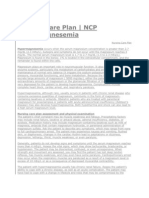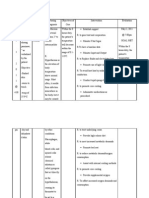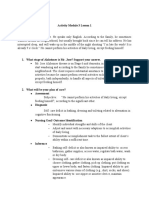NCP
NCP
Uploaded by
msinsanoCopyright:
Available Formats
NCP
NCP
Uploaded by
msinsanoOriginal Title
Copyright
Available Formats
Share this document
Did you find this document useful?
Is this content inappropriate?
Copyright:
Available Formats
NCP
NCP
Uploaded by
msinsanoCopyright:
Available Formats
DATE /TIME
CUES
NEEDS
NSG. DIAGNOSIS
OBJECTIVE OF CARE
INTERVENTION
EVALUATION
M A R C H
Subjective cue: Ginagmay lng
S L E E P
Sleep pattern Within 2 days 1. disturbance related span of
Assess
client
and
Goal partially
care, family usual sleep pattern, met, within 2 changes and at that what the have days span of was care, time. patient was the was
akong tulog mam as verbalized by the patient.
to the patient will any
mental illness be able to sleep occurred, secondary to for Bipolar about 6-8 happening if
1 hours per night Identify without disturbances.
there event
a able to sleep
2, Objective cues: 2011 y poor sleep pattern (2-3 hours per night) T y Frequent P A
Disorder Manic Phase.
precipitating
around for about 4-5
onset of sleep problem or if hours per night its chronic. Information from without both client and family disturbances. sleep
clarifies Scientific
specific
disturbance.
Yawning y y y y Restlessness Irritability Lethargy dark circles under eyes y Daytime
T E R N
Basis: Studies indicate abnormal sleep electroencep halograms in many individuals with mood disorders. This has led to the theory that disorder mood many
2.
Instruct patient to
follow as consistent a daily schedule for retiring and arising as possible. This promotes regulation of the circadian rhythm, and reduces the energy required for adaptation to changes. 3. Instruct to avoid large
Sleepiness y y Poor eye contact Decrease attention span y decrease ability to function
fluid intake before bedtime. This helps patients who otherwise may need to void during the night. 4. Increase daytime
physical activities as
reflects abnormal regulation of circadian rhythm Source: Doenges, Moorhuse and Murr. 2011.Davis Nurses Pocket Guide. Edition 12th
indicated. This reduces stress and promotes sleep. 5. Discourage pattern of
daytime naps unless deemed necessary to meet sleep requirements or if part of ones usual pattern. Napping can disrupt normal sleep patterns; however, elderly patients do better with frequent naps during the day to counter their shorter nighttime sleep schedules. 6. Suggest to client that if
he does not feel drowsy after 20 minutes, get up and
engage in quiet activity that is boring- not stimulating. Waiting that will not come can increase anxiety and frustration. Doing something monotonous at bedtime might have the client become drowsy. 7. Develop a sleep
relaxation program with client (e.g., progressive muscle imagery). both physical
relaxation, Employing
and mental relaxation can help minimize anxiety and promote sleep.
8.
Review sleep hygiene with the client.
measures
Determine if the client does any of the ff: refrain from naps, alcohol and caffeine at night; follow a regular retiring and arising schedule;
exercise pattern. Identifying baseline helps target
needed interventions.
DATE /TIME
CUES
NEEDS
NSG. DIAGNOSIS
PLAN OF CARE
INTERVENTION
EXPECTED OUTCOME
M A R C H
Subjective:
S E L
Objective cues: Somatic Delusion Flight of ideas Circumstantiality Excessive talking Decrease attention span y Poor eye contact
y 2, y y 2011 y y
P E R C
Risk for Impaired Within 1 hour 1. Establish rapport to the social interaction span of care, patient. establishing related to patient will be rapport will promote disturbed able to develop participation and trust. thought process trusting 2. Observe patient while secondary to relationship relating to family. To Bipolar 1 with the note prevalent Disorder Manic student nurse interaction pattern. Phase. within the 3. Determine patients use of reasonable coping skills and defense period of time. mechanism affects Scientific ability to be involved in
Within 1 hour span of care, patient was
able to develop trusting relationship with student within reasonable period of time. the nurse the
E P T I O N
Basis: Impaired social
social situation. 4. Provide positive reinforcement for improvement in social behaviors and interaction. or encourages continuation of desired behaviors and effort s for change. 5. Correct clients
interaction is an insufficient excessive quantity ineffective quality of social exchange. REFERENCE: Doenges, Moorhuse Murr. Davis Pocket and 2011. Nurses Guide. or
description of inaccurate perception, and describe the situation as it exists in reality. Explanation of, and participation in, real situations and real
12th Edition
activities interferes with the ability to respond delusions or hallucinations. 6. Do not argue or deny the belief. Use reasonable doubt as a therapeutic technique. Arguing with the client or denying the belief serves no useful purpose, because delusional ideas are not eliminated by approach and the development of a trusting relationship
may be impeded. 7. Give positive reinforcement when client is able to differentiate between reality- based and non-reality- based thinking. Positive reinforcement enhances self- esteem and encourages repetition of desirable behaviors. 8. Provide supportive group therapy when indicated. Positive feedback from group members will increase self- esteem.
9. Provided feedback to patients negative feelings. To allow the patient experience different views. 10. Encourage to validate perception with others. help patient prioritize those behaviors needing change.
You might also like
- Basics of SyscohadaDocument5 pagesBasics of Syscohadapg0utamNo ratings yet
- NCP For Gouty ArthritisDocument3 pagesNCP For Gouty ArthritisMolly HollyNo ratings yet
- NCP Cavernous Sinus ThrombosisDocument3 pagesNCP Cavernous Sinus ThrombosisVencel Mae Famas Villahermosa50% (2)
- DM NCPDocument2 pagesDM NCPVirgilio Reyes ManuelNo ratings yet
- Development of Varied Assessment ToolsDocument16 pagesDevelopment of Varied Assessment ToolsAlliah Jane Delfin100% (3)
- Diatonic Chords Mm2Document1 pageDiatonic Chords Mm2NicolasNo ratings yet
- Nursing Care Plan Format Name: - Medical Diagnosis: - DateDocument2 pagesNursing Care Plan Format Name: - Medical Diagnosis: - DateSheryl Ann Barit PedinesNo ratings yet
- X. Nursing Care Plan: ObjectiveDocument6 pagesX. Nursing Care Plan: ObjectiveRenea Joy ArruejoNo ratings yet
- Ineffective Tissue PerfusionDocument5 pagesIneffective Tissue PerfusionApryll Kristin Villaluna ZafeNo ratings yet
- Problem Nursing Diagnosis Background Knowledge Goal and Objective Nursing Intervention Rationale EvaluationDocument2 pagesProblem Nursing Diagnosis Background Knowledge Goal and Objective Nursing Intervention Rationale Evaluationcherrymae mataNo ratings yet
- NCP - Pulmonary TuberculosisDocument6 pagesNCP - Pulmonary TuberculosisastrijuNo ratings yet
- ncp-Nursing-Diagnosis - Ineffective - 510.htmlDocument2 pagesncp-Nursing-Diagnosis - Ineffective - 510.htmlrayearth_109368No ratings yet
- Ineffective Tissue Perfusion Related To Decrease Hemoglobin Concentration in The BloodDocument2 pagesIneffective Tissue Perfusion Related To Decrease Hemoglobin Concentration in The BloodKit Alizon BarredoNo ratings yet
- PUCAN, Julienne BSN III-D - NCP - HYPO&HYPERCHLOREMIADocument2 pagesPUCAN, Julienne BSN III-D - NCP - HYPO&HYPERCHLOREMIAJulienne PucanNo ratings yet
- BSN 215 Reflection Essay - LagoDocument2 pagesBSN 215 Reflection Essay - LagoAlliahkherzteen LagoNo ratings yet
- Nursing Care PlanDocument2 pagesNursing Care PlanCindy Mae Quinga100% (2)
- Sample NCP Table With Sample Priorotization and Justification of ProblemsDocument8 pagesSample NCP Table With Sample Priorotization and Justification of ProblemsCharm TanyaNo ratings yet
- JDM Care PlanDocument5 pagesJDM Care PlangopscharanNo ratings yet
- NCP Imbalanced NutritionDocument7 pagesNCP Imbalanced NutritionNora VarshavskiNo ratings yet
- Medications To Continue at Home Exercise Treatments Health Teachings Outpatient Diet Sexuality/ SpiritualityDocument2 pagesMedications To Continue at Home Exercise Treatments Health Teachings Outpatient Diet Sexuality/ SpiritualityMae EstilloreNo ratings yet
- Nursing Care PlanDocument1 pageNursing Care Plan洪卓澧No ratings yet
- Anxiety Disorders PDFDocument29 pagesAnxiety Disorders PDFKhyle TolentinoNo ratings yet
- Nursing Care Plan: Risk For Ineffective Airway Clearance Related To Bleeding From Tonsillectomy Short TermDocument4 pagesNursing Care Plan: Risk For Ineffective Airway Clearance Related To Bleeding From Tonsillectomy Short TermErika Danalle ArceoNo ratings yet
- NCP For PainDocument3 pagesNCP For Painjordan aguilarNo ratings yet
- NCP 1 Nursing DiagnosisDocument6 pagesNCP 1 Nursing DiagnosisJosh BlasNo ratings yet
- Sample TCP - GraceGuitguitenDocument4 pagesSample TCP - GraceGuitguitenLauren JalandoniNo ratings yet
- NCP of Endometrical CancerDocument2 pagesNCP of Endometrical CancerFrando kennethNo ratings yet
- NCPDocument10 pagesNCPJose CousinsNo ratings yet
- Revised NCPDocument8 pagesRevised NCPKryza Dale Bunado BaticanNo ratings yet
- TPN NCPDocument10 pagesTPN NCPArabylle Maranca AbuelNo ratings yet
- Nursing Care Plan: Subjective: Short TermDocument3 pagesNursing Care Plan: Subjective: Short TermJohn Lenbert PalaroanNo ratings yet
- Atkin's Case B4Document3 pagesAtkin's Case B4Windi Dawn Salleva50% (2)
- 3nu08 - Sesperes - Quiz On Medication Calculation and Iv RegulationDocument4 pages3nu08 - Sesperes - Quiz On Medication Calculation and Iv Regulationbea SesperesNo ratings yet
- Health History Format BlankDocument32 pagesHealth History Format BlankRich-Anne LagarasNo ratings yet
- Chapter 23Document13 pagesChapter 23Marti GregorioNo ratings yet
- Nursing Care Plan For Gunshot Wound To The Head: Assessment Diagnosis Planning Intervention Rationale EvaluationDocument13 pagesNursing Care Plan For Gunshot Wound To The Head: Assessment Diagnosis Planning Intervention Rationale EvaluationWeji ShNo ratings yet
- Appendicitis NCPDocument5 pagesAppendicitis NCPEarl Joseph DezaNo ratings yet
- NCP Acute Pain WDocument1 pageNCP Acute Pain Wmiles sbNo ratings yet
- Health Teaching Plan AMLDocument2 pagesHealth Teaching Plan AMLInah Floresta BesasNo ratings yet
- Ateneo de Zamboanga University: Case Study (HOSPITAL)Document7 pagesAteneo de Zamboanga University: Case Study (HOSPITAL)Lyka SaysonNo ratings yet
- Brent Hospital and Colleges IncorporatedDocument4 pagesBrent Hospital and Colleges Incorporateddaniel gariandoNo ratings yet
- LFD PediaDocument1 pageLFD PediaAphrill Pearl PacisNo ratings yet
- GRP 3 2 Renal Nephrectomy NCPDocument6 pagesGRP 3 2 Renal Nephrectomy NCPPam RomeroNo ratings yet
- NCP RheumatoidDocument5 pagesNCP RheumatoidJane Elizabeth Gonzales MacahiaNo ratings yet
- Finals NCMB418Document24 pagesFinals NCMB418Jiro MarianoNo ratings yet
- Assessment Diagnosis Planning Intervention Rationale EvaluationDocument3 pagesAssessment Diagnosis Planning Intervention Rationale EvaluationKyla CalzadoNo ratings yet
- NCP ImmobiltyDocument4 pagesNCP ImmobiltyAlizza Therese Severo AnzanoNo ratings yet
- NCPDocument6 pagesNCPNik Rose ElNo ratings yet
- NCP FinalDocument5 pagesNCP FinalVenus BonglayNo ratings yet
- Assessment Explanation of The Problem Planning Nursing Intervention Rationale EvaluationDocument2 pagesAssessment Explanation of The Problem Planning Nursing Intervention Rationale EvaluationRodolfo Bong SemaneroNo ratings yet
- As Needed.: Environmental Stimuli 6Document4 pagesAs Needed.: Environmental Stimuli 6Nicole GumolonNo ratings yet
- Febrile Seizures NCPDocument9 pagesFebrile Seizures NCPNurul IrhamnaNo ratings yet
- NCP FinalDocument4 pagesNCP FinalKathrina CraveNo ratings yet
- Assessment Nursing Diagnosis Scientific Basis Planning Interventions RationaleDocument3 pagesAssessment Nursing Diagnosis Scientific Basis Planning Interventions RationaleJose Rey BuenavistaNo ratings yet
- NCP CPDocument8 pagesNCP CPxacharoweeNo ratings yet
- Our Lady of Fatima UniversityDocument2 pagesOur Lady of Fatima UniversityAllisson BeckersNo ratings yet
- Nursing Care Plan On HypertensionDocument5 pagesNursing Care Plan On Hypertensionbhavana100% (1)
- ALMOETE Bullous ImpetigoDocument4 pagesALMOETE Bullous ImpetigoGail NamangdanNo ratings yet
- Activity. Module 3 Lesson 1Document5 pagesActivity. Module 3 Lesson 1NightyNo ratings yet
- Nursing Diagnosis Nursing Intervention Rationale: Prioritized Nursing Problem For AnemiaDocument2 pagesNursing Diagnosis Nursing Intervention Rationale: Prioritized Nursing Problem For AnemiaMyrshaida Ibrahim0% (1)
- Teaching Plan Deviced For Teenage Mother and NewbornDocument34 pagesTeaching Plan Deviced For Teenage Mother and NewbornYzel Vasquez AdavanNo ratings yet
- Counselling LetterDocument1 pageCounselling LetterSeann LorescoNo ratings yet
- The Ride of Your Life: What I Learned about God, Love, and Adventure by Teaching My Son to Ride a BikeFrom EverandThe Ride of Your Life: What I Learned about God, Love, and Adventure by Teaching My Son to Ride a BikeNo ratings yet
- 01 +Projectile+Motion+L-1Document29 pages01 +Projectile+Motion+L-1Pokala KrishnavamshiNo ratings yet
- QuizDocument4 pagesQuizmohanaaprkashNo ratings yet
- Integrity Constraints and TriggersDocument12 pagesIntegrity Constraints and Triggersapi-26434328100% (1)
- Chapter 1Document5 pagesChapter 1monique gonzalesNo ratings yet
- Americas Greatest Criminal Barracks by GilfoyleDocument30 pagesAmericas Greatest Criminal Barracks by GilfoyleRonHuettNo ratings yet
- 30secondary GlaucomasDocument9 pages30secondary GlaucomasArtha CimutNo ratings yet
- Important Questions HoEADocument4 pagesImportant Questions HoEAKadire Shivani ReddyNo ratings yet
- Student Assessment Tasks: AISL Pty LTD T/A Rosehill College RTO No: 41257 - CRICOS Code: 03622ADocument25 pagesStudent Assessment Tasks: AISL Pty LTD T/A Rosehill College RTO No: 41257 - CRICOS Code: 03622AMichelle SukamtoNo ratings yet
- Risk Management SDP Delivery PlanDocument15 pagesRisk Management SDP Delivery Plansolamin28No ratings yet
- Tony Lynn Brasfield v. Cheryl Denise Brasfield, 36 F.3d 1105, 10th Cir. (1994)Document2 pagesTony Lynn Brasfield v. Cheryl Denise Brasfield, 36 F.3d 1105, 10th Cir. (1994)Scribd Government DocsNo ratings yet
- Esquema 322Document5 pagesEsquema 322recambiosmlsNo ratings yet
- Neonatal Resuscitation Program™ (NRP) : Online Examination, 6th EditionDocument3 pagesNeonatal Resuscitation Program™ (NRP) : Online Examination, 6th Editionmahi_elsemary7011No ratings yet
- People V de La Cruz, G.R. No.187683, February 11, 2010: The FactsDocument6 pagesPeople V de La Cruz, G.R. No.187683, February 11, 2010: The FactsVitz IgotNo ratings yet
- Anger Management QuestionnaireDocument4 pagesAnger Management Questionnaireaqsa rao100% (2)
- QUARTER 3 SUMMATIVE TEST NO. 1 IN English 3Document3 pagesQUARTER 3 SUMMATIVE TEST NO. 1 IN English 3jonathan100% (1)
- XJ40 1991-92 3,2L 4L Boite Vitesse AutoDocument59 pagesXJ40 1991-92 3,2L 4L Boite Vitesse AutoTACHONNo ratings yet
- Lecture - German Consonant PronunciatonDocument7 pagesLecture - German Consonant PronunciatonSophiaNo ratings yet
- Paradichlorobenzene Risk Assessment EUDocument170 pagesParadichlorobenzene Risk Assessment EUJoelle Faye CortezNo ratings yet
- Teaching Demo RubricDocument2 pagesTeaching Demo RubricBeverage A. SarzaNo ratings yet
- Words 1 PracticeDocument26 pagesWords 1 PracticeKurt ChenNo ratings yet
- Reading ComprehensionDocument20 pagesReading ComprehensionmterranoNo ratings yet
- RFP GMRCL - DDC Metro BhavanDocument194 pagesRFP GMRCL - DDC Metro BhavanpandyatusharNo ratings yet
- Reit PPT Vornado Realty Trust PresentationDocument42 pagesReit PPT Vornado Realty Trust PresentationDaniel GoytrNo ratings yet
- DevZone Zend - PDF TutorialDocument10 pagesDevZone Zend - PDF Tutorialbeway9002No ratings yet
- Moon Knight (TV Series) : PremiseDocument9 pagesMoon Knight (TV Series) : PremiseChetankumar AkarteNo ratings yet
- Rajasthan Rajya Vidyut Utpadan Nigam Limited: DT./GR A B C D Mon DT./GR A B C D Mon DT./GR A B C DDocument7 pagesRajasthan Rajya Vidyut Utpadan Nigam Limited: DT./GR A B C D Mon DT./GR A B C D Mon DT./GR A B C DSE ElectricalNo ratings yet
- Functions of Social WorkDocument3 pagesFunctions of Social WorkmuhammedrafiNo ratings yet

























































































